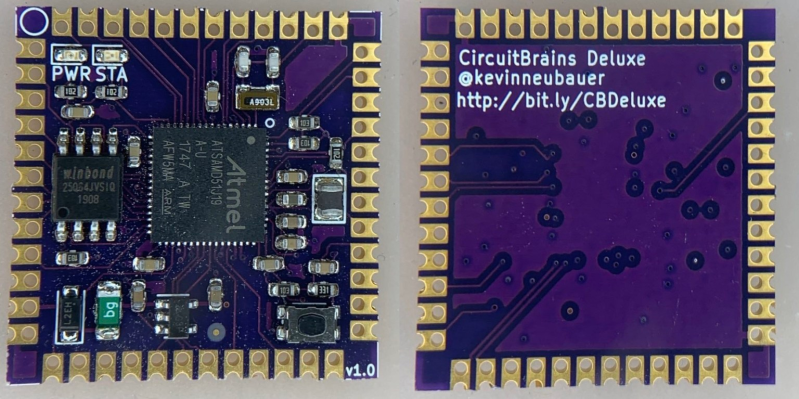Whether you’re new to electronics and programming, or you were bit-banging bare metal long before hair metal, CircuitPython is a great tool for getting a project up and working without all the fuss. The boards show up as mass storage devices, and programming consists of editing the Python file and saving it back to the board.
The only hard part about CircuitPython is trying to cram those official boards into small projects. [Kevin Neubauer] got tired of making his own board every time and came up with a slim system-on-module that has all the core functionality of CircuitPython. CircuitBrains Deluxe has regular holes for using headers, but also has castellated pads so he can solder these modules directly to a larger project PCB. [Kevin] says these are still in the testing and cost-optimization phase, but we would totally buy a few of them.
[Kevin] probably has a programming method for this module in mind already. But if you find yourself mystified by castellated pads, take a look at this pogo pin programmer built for ESP8266s. If your problem is pitch-related, maybe you can save the day with a breakout board.
Thanks to [Drew Fustini] for the tip!















Ahh. So this explains the spike in my website traffic. Thanks Drew! Thanks Hackaday! :-)
I am waiting on another board revision and then I hope to do a small production run to have some stock for me and some to sell. Follow me on Twitter if you want up-to-date status on my creations. @kevinneubauer
These ~square-inch tiles are fun – congrats on the cool project!
I made some of these with STM32s awhile ago, but it turned out to be tough to find ways to integrate them into projects because of the form-factor. Out of the few dozen that I assembled, I only used a couple for simple control loops before deciding that it didn’t save me much time compared to just designing a chip into a board.
One exception is boards that you etch or mill yourself; it’s hard to get the 0.4mm – 0.5mm pitch that you need for those QFN packages on DIY PCBs, so it can be nice to have a few of these tiles on hand for ideas that you absolutely have to try in an afternoon.
I hope this project’s author can find more uses for the form factor than I did!
Thanks to this, I know the name of the thing I wanted: castellated pads.
Now, how do I add these to a design in KiCad?
You can put two identical rows of headers with square pads next to each other and make the board edge bisect the outer copy’s holes.
Or you could make a custom footprint, ofc. I wonder if newer versions will add them to the standard footprint libraries (or if they have already).